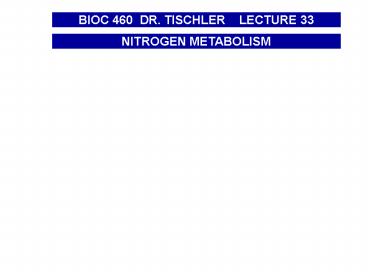NITROGEN METABOLISM - PowerPoint PPT Presentation
1 / 14
Title:
NITROGEN METABOLISM
Description:
1. Describe the transaminase, and glutamate dehydrogenase ... negative: synthesis degradation (e.g., starvation, trauma, cancer cachexia) -Amino acid ... – PowerPoint PPT presentation
Number of Views:206
Avg rating:3.0/5.0
Title: NITROGEN METABOLISM
1
BIOC 460 DR. TISCHLER LECTURE 33
NITROGEN METABOLISM
2
OBJECTIVES
- 1. Describe the transaminase, and glutamate
dehydrogenase reactions and discuss their roles
in the removal of nitrogen waste in the body. - Describe the urea cycle
- Describe the phenylalanine hydroxylase reaction
and explain its relationship to phenylketonuria. - 4. List the steps in the conversion of heme to
conjugated bilirubin. - 5. Define jaundice.
3
PHYSIOLOGICAL PREMISE Have you ever carefully
read a packet of EqualTM? If so, you may have
noticed a warning to phenylketonurics. The
chemical sweetener in equal is a dipeptide
containing phenylalanine and aspartate. Some
individuals are born with one of the more common
amino acid disorders, phenylketonuria. They are
unable to metabolize phenylalanine to tyrosine.
Consequently vast amounts of phenylalanine will
accumulate in the blood if too much of this amino
acid is consumed in the diet. Constant excess of
phenylalanine in the blood can cause severe
mental retardation. Hence this is one of several
diseases tested for in newborns in all states.
4
Table 1- The essential and non-essential amino
acids
a Arg is synthesized in the urea cycle, but the
rate is too slow to meet the needs of
growth in children b Met is required to
produce cysteine if the latter is not supplied
adequately by the diet. c Phe is needed in
larger amounts to form tyr if the latter is not
supplied by the diet.
5
Amino Acid Pool
Figure 1. Sources and fates of amino acids
6
PROTEIN BALANCE
- positive synthesis gt degradation (e.g.,
growth, body building) - negative synthesis lt degradation (e.g.,
starvation, trauma, cancer cachexia)
7
?-Amino acid
?-Ketoglutarate
Cofactor pyridoxal phosphate
?-Keto acid
Glutamate
Figure 2. Depiction of a general transamination
(aminotransferase) reaction. The ?-amino acid
other than glutamate can be a wide variety
8
Figure 3. In non-hepatic tissues the linked
reactions of glutamate dehydrogenase and
glutamine synthetase remove two ammonia molecules
from the tissues as a way of ridding the tissues
of nitrogen waste. The glutamine deposits the
ammonia in the kidney for excretion.
9
Figure 4. In liver, nitrogen waste from amino
acids ends up in urea. Amino acids are derived
either from the breakdown of protein in various
tissues or from what is synthesized in those
tissues
10
CYTOPLASM
MITOCHONDRIA
-OOC-CH-NH3 ? CH2COO-
? argininosuccinate synthetase
? argininosuccinase
?arginase
Figure 5. Carbamoyl phosphate synthetase
reaction and the urea cycle. Overall
3ATPHCO3-NH4asp ? 2ADPAMP2PiPPifumarateur
ea
11
UREA CYCLE FACTS
- Found primarily in liver and lesser extent in
kidney - Nitrogen added to the urea cycle via carbamoyl
phosphate and aspartate - Carbamoyl phosphate synthetase is
allosterically activated by N- acetylglutamate - (acetyl CoA glutamate ? N-acetylglutamate)
12
HYPERAMMONEMIAS Acquired Liver disease leads to
portal-systemic shunting Inherited Urea cycle
enzyme defects of CPS I or ornithine
transcarbamoylase lead to severe hyperammonemia
13
Phenylalanine hydroxylase
primary defect in phenylketonuria
O2
H2O
X
Phenylpyruvate
Tyrosine
Phenylalanine
Dihydrobiopterin
Tetrahydrobiopterin
Phenyllactate
Phenylacetate
NADPH
NADP
Figure 6. Unusual compounds produced from
phenylalanine in phenylketonuria. The
phenylalanine hydroxylase reaction (or
regeneration of the tetrahydrobiopterin cofactor)
are defective in phenylketonuria.
14
BLOOD CELLS
KIDNEY
INTESTINE
LIVER
Figure 7. Catabolism of hemoglobin































